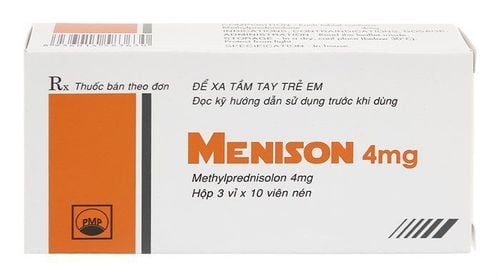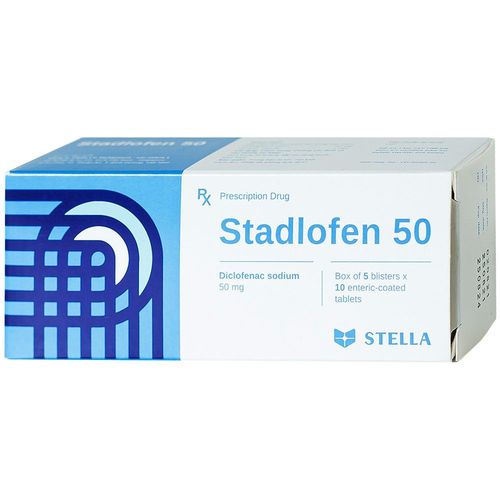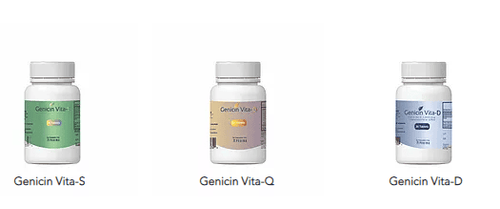This is an automatically translated article.
Tenoxicam is a prescription drug, often used in the treatment of musculoskeletal conditions such as rheumatoid arthritis, tendonitis, bursitis. So what does Tenoxicam do and how does it work?
1. What are the effects of Tenoxicam?
What does Tenoxicam do? Tenoxicam is a non-steroidal anti-inflammatory drug, it has significant anti-inflammatory and analgesic effects, and also has a somewhat hypothermic effect. As with other nonsteroidal anti-inflammatory drugs, the exact mechanism of action of tenoxicam is currently unknown, although it is currently hypothesized that this drug inhibits cyclooxygenase - a substance that inhibits important role in the inflammatory process.
Tenoxicam is commonly used for symptomatic treatment in degenerative joint diseases and rheumatoid arthritis, soft tissue lesions (short-term use). Tenoxicam has no effect on the progression of rheumatoid arthritis.
Tenoxicam, like other non-steroidal anti-inflammatory drugs, it harms the gastrointestinal tract by reducing prostaglandin synthesis leading to inhibition of mucin production - a substance with a protective effect on the gastrointestinal tract. Prostaglandins also have a role in maintaining renal perfusion, and Tenoxicam inhibits prostaglandin synthesis, so it can cause interstitial nephritis, glomerulonephritis, renal papillary necrosis and nephrotic syndrome, especially in patients with renal failure. patients with kidney disease or chronic heart failure. In these patients, the use of nonsteroidal anti-inflammatory drugs may increase the risk of acute renal failure and acute heart failure.
Tenoxicam is prepared in the following drug forms:
20mg tablets. Powder for injection, 20 mg vial. Suppositories rectal 20mg.
2. Indications and contraindications of the drug Tenoxicam
Tenoxicam is indicated in the following cases:
Symptomatic treatment of diseases: Rheumatoid arthritis Ankylosing spondylitis Fiessinger - Leroy - Reiter syndrome Psoriatic arthritis Osteoarthritis. Short-term treatment of acute musculoskeletal disorders: Excessive muscle strains Sprains Other soft tissue injuries. Exacerbation of osteoarthritis such as: Psoriatic periarthritis Tendonitis Bursitis Acute post-traumatic disease of the musculoskeletal system. Severe low back muscle pain. Tenoxicam is contraindicated in the following cases:
Advanced gastrointestinal ulceration or a history of peptic ulcer disease, gastrointestinal bleeding. Asthma, patients prone to bleeding risk such as cirrhosis, heart failure, kidney failure (Clcr < 30ml/min). Hypersensitivity to tenoxicam or to any other ingredient of the drug. Patients with a history of hypersensitivity to aspirin or other non-steroidal anti-inflammatory drugs. Pregnant women in the last 3 months of pregnancy. Diverticulitis can be widespread. Phenylketonuria colitis. Children < 15 years old.
3. Dosage and how to take Tenoxicam
Dosage of Tenoxicam should be according to the doctor's prescription, the reference dose for adults is as follows:
Oral: Use a single dose of 20mg/day, taken at the same time every day. For some patients, just 10mg, once a day, is enough. Prescription doses are usually limited to 20mg/day. Intramuscular or intravenous injection: Use a single dose of 20mg/day, for 1 or 2 days if the patient cannot take it orally, then continue to use it as an oral drug. Once mixed, the medicine must be used immediately. Tenoxicam is also administered rectally. Patients with renal impairment: Clcr > 25 ml/min: Use the usual dose but carefully monitor. Clcr < 25 ml/min: There are not enough data to recommend the dose of Tenoxicam in this case. Some notes when using Tenoxicam:
High doses of Tenoxicam should not be used, because it often does not achieve a significantly higher effect but increases the risk of side effects. In the symptomatic treatment of acute musculoskeletal diseases, Tenoxicam usually only needs to be used within 7 days, however, in severe cases, the drug can be used for up to 14 days. Patients need to take Tenoxicam when full with a full glass of water about 150 ml. Avoid the use of alcoholic beverages. Symptoms of Tenoxicam overdose usually include:
Nausea, vomiting Epigastric pain Rarely diarrhea Gastrointestinal bleeding Tinnitus Headache Blurred vision Dizziness. Treatment for overdose of Tenoxicam is as follows:
The patient should be gastric lavage as soon as possible and closely monitored, supportive treatment if necessary. Vomiting is possible to remove Tenoxicam, but ipeca syrup should not be used, as it can cause symptoms similar to Tenoxicam poisoning, complicating the diagnosis further. Activated charcoal can be used, but the effect of activated charcoal on reducing Tenoxicam absorption has not been determined if given after two hours. If you forget to take a dose of Tenoxicam by mouth, take it as soon as you remember. However, if it is almost time for your next dose, skip the missed dose and take your next dose of Tenoxicam at the scheduled time, do not double the prescribed dose.
4. Tenoxicam side effects
Common side effects of Tenoxicam include:
Headache Dizziness Epigastric pain Nausea Indigestion Outer rash Urticaria Itching. Less common side effects of Tenoxicam include:
Fatigue, Edema, Dry mouth, Palpitations, Persistent constipation, Diarrhea, stomatitis, gastrointestinal bleeding, Peptic ulcer, Gastritis, Sleep disturbance, Edema . Rare side effects of Tenoxicam include:
Hypersensitivity reactions (asthma, anaphylaxis, angioedema). Anemia Leukopenia Agranulocytosis Thrombocytopenia Bleeding due to inhibition of platelet aggregation. Hypertension. Blurred vision Light sensitive skin Stevens-Johnson syndrome Toxic epidermal necrolysis (Lyell's syndrome). Difficulty urinating. If you experience any side effects of Tenoxicam, tell your doctor immediately or go to the nearest medical facility for timely support.
5. Interaction of Tenoxicam with other drugs
Use of Tenoxicam with antacids may decrease the rate of absorption but does not affect the extent of absorption of tenoxicam. Concomitant treatment of Tenoxicam with salicylates, aspirin or other nonsteroidal anti-inflammatory drugs or glucocorticoids should be avoided because of the increased risk of adverse reactions, especially gastrointestinal side effects. Non-steroidal anti-inflammatory drugs have been reported to cause lithium retention when used with them. Therefore, if tenoxicam is used in a patient on lithium therapy, the physician will need to increase the monitoring of lithium levels and the patient needs to maintain fluid intake and how to recognize the symptoms of toxicity. lithium for timely detection. Tenoxicam can cause water, sodium, and potassium retention and may affect the sodium excretion effect of diuretics, so the dose should be adjusted accordingly. These properties should be borne in mind when administering Tenoxicam to patients with decreased cardiac function or increased blood pressure because of the potential for aggravation of the disease. Administration of intravenous tenoxicam together with cholestyramine reduces the half-life of tenoxicam and increases tenoxicam clearance. Concomitant use of Tenoxicam with oral anticoagulants, heparin, and selective serotonin reuptake inhibitors, pentoxifylline, and adrenergic-serotonergic combinations increases the risk of bleeding. Use of Tenoxicam together with cyclosporin and tacrolimus has a risk of nephrotoxicity in the elderly. Concomitant use of Tenoxicam with diuretics, ACE inhibitors and angiotensin II receptor antagonists increases the risk of acute renal failure. The use of Tenoxicam with Tenofovir disoproxil is associated with an increased risk of nephrotoxicity. The use of Tenoxicam with beta-blockers (except esmolol) and oral glucocorticoids increases the risk of gastrointestinal bleeding. Tenoxicam is a prescription drug, commonly used in the treatment of musculoskeletal conditions such as rheumatoid arthritis, tendonitis, bursitis. To ensure the effectiveness of treatment and avoid unwanted side effects, patients need to strictly follow the instructions of the doctor, professional pharmacist.
Follow Vinmec International General Hospital website to get more health, nutrition and beauty information to protect the health of yourself and your loved ones in your family.
Please dial HOTLINE for more information or register for an appointment HERE. Download MyVinmec app to make appointments faster and to manage your bookings easily.













